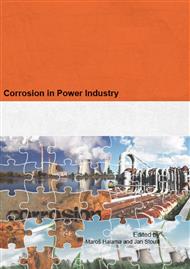p.3
p.11
p.23
p.31
p.41
p.49
p.59
p.63
p.67
Corrosion Degradation of Steel Pipes in Indirect Cooling Circuit of Gas Cleaning
Abstract:
The paper deals with corrosion damage to steel pipes which were a part of the indirect cooling circuit of gas cleaning. The pipes were made from steel ASTM A106 Gr.B. The outer surface of pipes of the inside part of the circuit was affected by flue gases with mean temperature of approximately 1200 °C. The pipes of the outside part of the circuit were exposed to outer environment with mean temperature of about 25 °C. The cooling water flowing in these pipes had mean temperature of about 20 °C and contained a corrosion inhibitor based on zinc chloride (with addition of hydrochloric acid, phosphoric acid and PBTC). Flow rate of cooling water was 3700 m3/h, its total volume 1500 m3, and the pressure of cooling water was 600 kPa. The achieved thickening of cooling water was N=4. Side filtering was accomplished by a filter DPF 4000. The pipes of the cooling circuit were welded to each other, which initiated stress stimulating development of cracks on the outer surface of pipes in the heat-affected zone, Fig.1. The existing technological conditions resulted in formation of deposits on the outer pipe surfaces. Their presence changed thermal conditions in steel pipes.
Info:
Periodical:
Pages:
41-48
Citation:
Online since:
December 2014
Authors:
Keywords:
Price:
Сopyright:
© 2015 Trans Tech Publications Ltd. All Rights Reserved
Share:
Citation:


